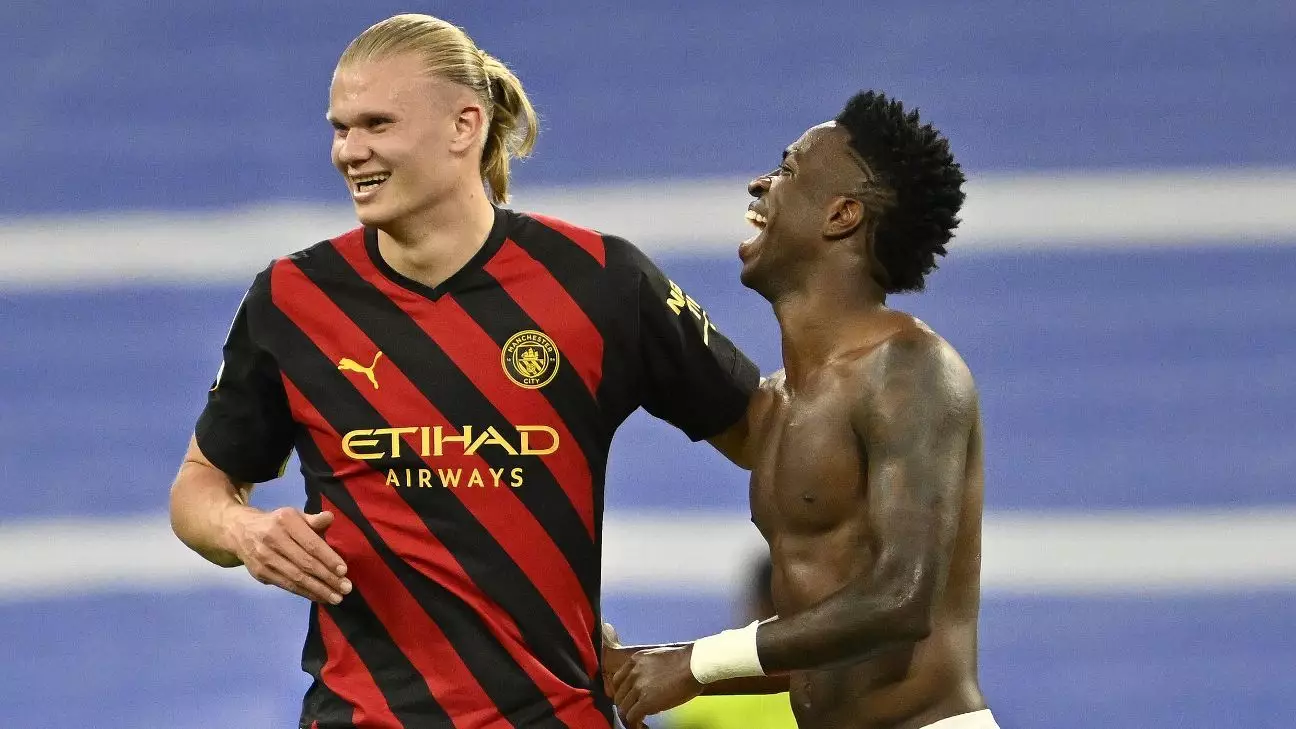As Real Madrid contemplates its future in the wake of potential high-profile departures, the spotlight has shifted squarely to Manchester City’s illustrious striker, Erling Haaland. With Vinícius Júnior facing scrutiny from clubs within the Saudi Pro League, Los Blancos are grappling with the prospect of losing a talent they have long celebrated. The idea of replacing the Brazilian with a player of Haaland’s caliber is tantalizing yet fraught with challenges. Given that the Norwegian has signed a nearly decade-long contract with City, Madrid must weigh the feasibility of such a transfer against the backdrop of potential financial sanctions looming over the Premier League champions due to ongoing investigations into their financial conduct.
The shift to Manchester City’s Haaland would mark a profound tactical change for Real Madrid, pushing star Kylian Mbappé to a more dynamic left-wing role, thus altering the offensive structure entirely. Such an adjustment not only hinges on tactical efficacy but also on the market realities of modern football, where megastars command equally mega salaries. In this financially unpredictable landscape, a move for Haaland could be labeled a gamble, one that might not align with the club’s historical prudence in transfers.
Defensive Fortifications: The Pursuit of Ibrahima Konaté
While much of the attention rests on offensive acquisitions, Real Madrid’s ambitions this summer are equally focused on bolstering their defensive lineup. This is particularly pertinent as they eye Liverpool’s Ibrahima Konaté, who could potentially become available if contract negotiations with the Reds stall. The French center-back is seen as a strong candidate to enhance Madrid’s resilience at the back, which has been a concern in recent campaigns.
Konaté’s rumored arrival could be complemented by other targets like Arsenal’s William Saliba, highlighting a revisited approach to the transfer window where Real Madrid seeks young, versatile talent. Identifying players at risk of contract evaporation is a tactical astuteness that signifies not just foresight but a calculated risk management strategy. Real Madrid needs to ensure its defensive line is not only swift but also formidable enough to compete at the highest European level.
The South American Connection: A New Era for Vinícius Júnior?
Vinícius Júnior’s potential exit could represent a watershed moment for the club. While the interest from the Saudi Pro League has raised critical eyebrows, it also generates transformative possibilities for both the player and the team. Real Madrid rightly understands the need to be proactive in retaining its stars while preparing for lucrative bids from leagues that are increasingly willing to invest heavily in top-tier talent.
If Vinícius departs, that might not just close a chapter; it could prompt a renaissance in Madrid’s attacking philosophy. The arrival of a powerhouse like Haaland could redefine expectations and energize a team that has always prided itself on relentless attacking football. However, this scenario places the decision-making power firmly in the player’s court. Will he seize the financial opportunity offered by the Gulf states, or pursue the glory and prestige tied to footballing temples like Madrid?
The Emerging Landscape of Player Contracts
The modern football landscape is undergoing a radical transformation, particularly concerning player contract negotiations. With contracts becoming a strategic tool for clubs seeking to maximize their bargaining position, talks involving players like Bukayo Saka at Arsenal suggest a broader trend across Europe where clubs are not just focusing on immediate results but also long-term sustainability.
Real Madrid’s acquisition strategy appears to align with this philosophy, exhibiting willingness to engage in proactive negotiations rather than reactive responses to player movements. The dynamics of football contracts are shifting—long-term deals are becoming increasingly prevalent, emphasizing the need for clubs to not only invest monetarily but also to cultivate the right environments for their players.
Such strategic maneuvers could redefine how clubs like Real Madrid navigate what appears to be a tumultuous transfer landscape. With interests from lucrative foreign leagues reshaping the player market, clubs will have to adapt quickly to maintain their status within the elite sphere of European football.
In this climate of uncertainty and opportunity, Real Madrid stands at a crossroads—one that demands ingenuity, boldness, and a touch of audacity. The direction they choose could reshape not only their immediate future but also their place within the pantheon of footballing greatness.

